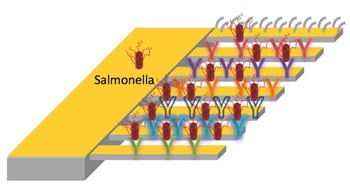They created a microcantilever-based technique for recognising Salmonella by exploiting the binding properties of peptides from phage display libraries.
Different strains of Salmonella are captured by microcantilevers decorated with peptides that have binding affinities to different strains of the pathogen.
The biosensor can be customized to detect any type of bacteria and different strains of the same bacterium, according to Rice University researchers and colleagues in Thailand and Ireland.
How it works
Microcantilevers were decorated with different peptides that can bind to strains of Salmonella.
When a peptide catches a bacterium, the cantilever bends slightly, due to a mismatch in surface stress on the top and bottom.

This method offers high sensitivity and holds promise for multiplexed analysis based on simultaneous testing of microcantilever arrays, said the researchers.
A fine laser trained on the mechanism catches that motion and triggers the alarm.
The Rice lab compared the peptides’ performance with commercial antibodies for Salmonella detection and found they were more sensitive and could be used in a multiplexed cantilever array to detect different kinds of Salmonella at once.
Sibani Lisa Biswal, a Rice biomolecular engineer, told the university that the peptides are very robust
“That’s why a lot of people like them over antibodies. The peptides can handle harsher conditions and are much more stable. Antibodies are large proteins and break down more readily.”
The system is sensitive enough to warn of the presence of a single pathogen, according to the researchers.
“One particular peptide, MSal 020417, demonstrated a higher binding affinity to Salmonella spp. than the commercially available antibody and is able to distinguish among eight Salmonella serovars on a microcantilever,” said the researchers.
Peptides binding properties
A multiplexed screening system to determine the binding affinities of various peptides to a particular pathogen improves the efficiency of the peptide screening process.
Combined with phage-derived peptides, this microcantilever-based technique provides a novel biosensor to detect pathogens and holds potential to be developed as a screening method to identify pathogen-specific recognition elements.
Conventional methods, including culture and colony counting, immunology-based and polymerase chain reaction (PCR), have been used for detection however, these techniques can be tedious or time-consuming or require pretreatment or labeling of samples.
The researchers said that by immobilizing a collection of peptides that present high selectivity for different bacterial pathogens, a multiplexed detection system could detect multiple pathogens simultaneously, improving the detection efficiency of the biosensor.
Source: Analytical Chemistry
Online ahead of print, DOI: 10.1021/ac403437x
“Rapid Detection of Pathogenic Bacteria and Screening of Phage-Derived Peptides Using Microcantilevers”
Authors: Jinghui Wang, M. Josephine Morton, Christopher T. Elliott, Nitsara Karoonuthaisiri, Laura Segatori and Sibani Lisa Biswal
